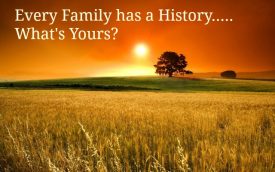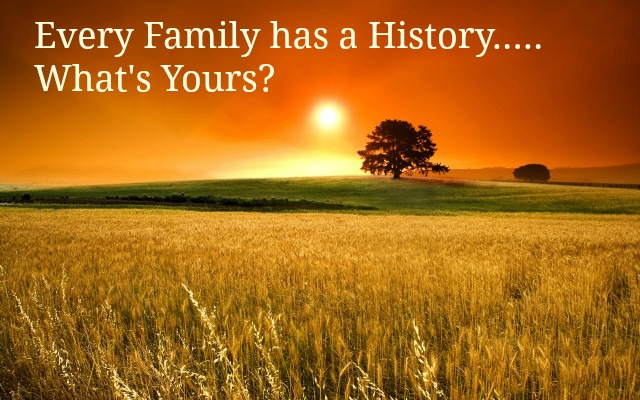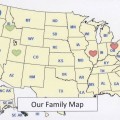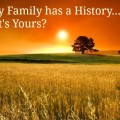Public records can supply a wealth of information regarding your ancestors and the lives they led. Before proceeding to discuss public records, here’s a review of the steps to take before looking for public records. The following graphic shows the steps of the family history research cycle.
Step 1: “Identifying what you know about your family” can be accomplished by looking for home sources of information and by talking to family members about what they know about your family.
In Step 2: “Decide what you want to learn”. You will want to organize the information you have collected, either in a family history software program or on paper forms. If you have only an approximate date for an event, record it as about a certain year or a span of years. Do the same with places, and use some sort of notation, maybe a question mark to indicate that it is a guess. As you are recording information, you will want to record your source of that information, whether it is a certificate, a journal entry or someone’s memory. Beware of depending on someone’s memory, even your own. Try to find documentation for every fact you have.
The best documentation, which is called a primary source, is recorded at the time of the event or reasonably soon after. A secondary source is one that records information long after the event occurred. I learned the importance of seeking out a primary source from my Grandma Mollie’s application for American citizenship which was filed in the 1930s. On the application, Mollie states that she arrived at the port of New York City, on the steamship, Cedric, in September 1904. I grew frustrated when, despite searching the Ellis Island website, I could not find Mollie entering the United States. It should have been so easy with both the name of the ship and the date of arrival. Then I accidentally discovered that it was not Mollie, but one of her sisters, who had arrived on the Cedric in September 1904! I then expanded my search, no longer basing it on false information, and quickly found that Mollie had arrived on the ship, Teutonic in June, 1904. In the grand scheme of things, does it really matter whether my grandmother arrived in the United States in June or September of 1904? No. Why it matters to me is what I learned about my Grandma Mollie from the ship’s manifest that gave me the true date of her arrival. I was only eight years old when Mollie died. While I may have had some understanding that she had come from Ireland, I certainly never asked her about the trip. From the ship’s manifest, I learned that she had departed from the port of Queenstown, now Cobh, Ireland, which was 280 miles from her family’s farm. Mollie was just 16 years old with five dollars in her possession when she arrived in New York City. While her destination was her brother’s home in Brooklyn, New York, she made the 8 day trip across the Atlantic alone without the companionship of family! The ship manifest gives no information regarding how she made the trip from her family’s farm to her port of departure. I don’t know when she said good-bye to her parents, but I don’t think she ever saw them again. I certainly did not take a life changing step like that when I was 16 years old!
The discrepancy between the arrival date on the ship manifest and what Mollie remembered almost 30 years later and put on her application for citizenship is the difference between a primary source and secondary source. The difference is time. The sooner information is recorded, the more likely it is to be accurate. When choosing a public record, look first for a primary source document. This brings us to Step 3: Select a record to search.
The type of record you will want to select will depend on the type of information you are seeking. Look for the holes, that is, the missing birth, death, marriage information on your pedigree chart and family group sheets for a place to start. Here’s a list of suggestions for records to select to find frequently desired information. Included in these sources are the family records that you may have already found, because, while they are not public records, sometimes they are the best or the only records available.
-
Where to find birth records: A good primary source would be the government recording of a birth. Church christening records and family Bible records often predate the creation of government records and are considered primary sources. Secondary sources for a birth record would be military records, census records and obituaries. When using a census record to determine age, use the earliest census on which your ancestor appears.
-
Where to find death records: A government record of death would be a good primary source, and usually the recording of deaths began before the recording of births. Church, cemetery records, and obituaries are also good sources. Death records are not a reliable source for birth information or who the parents of the deceased were. When a person lives a normal life span, the deceased is frequently the only one who was present for both their birth and death. Those who supply information for a death certificate are often sharing second-hand information. A death certificate is a good example of how a record can be both a primary and a secondary source. It is a primary source for the information it contains regarding the death. It is a secondary source for the other information it contains, like the person’s birthdate.
-
Where to find marriage records and the woman’s maiden name: Again, government vital records, church, and family Bibles are good sources for marriage information. Newspapers might have an engagement or wedding announcement. A census record that includes a mother-in-law residing in the household would supply the probable maiden name of the wife. Relationships reported in a census are the individual’s relationship to the head of household. So, in the case of the head of household being a husband, a mother-in-law would be the wife’s mother. A cemetery headstone might also include a marriage date.
-
Where to look for emigration and immigration records: Emigration is leaving a place, and several of the European countries kept a record of their citizens who left. Immigration is entering a country, and most countries keep records of that in some form or other. A ship’s manifest is a good record for immigration information. Applications for citizenship can also be helpful; just note how soon they were filed after the person’s entry into the country. The 1920 US Census has the immigration year for those of foreign birth and whether they are naturalized citizens. Also keep in mind while looking for naturalization records, the wife and children sometimes received citizenship when the man of the family did, so there may not be separate records for them.
-
Who else was in your ancestor’s family and where did they live? Census records are a great place to start answering both these questions and are frequently available to search online. Church records, land records and probate records may supply answers too. A secondary source would be an obituary printed in a newspaper. Newspaper obituaries not only depend on the memory of the person supplying information but the accuracy of the person preparing the article for publication.
As already mentioned, an increasing number of records are available online, but many are not. In my article next week, I will share how to effectively use online resources and where you can look for those records that are not online yet. I will also cover the remaining steps of the research cycle.
Are you interested in being a volunteer blogger for LDSBlogs? Check out our open topics!
About Christine Bell
Christine Bell has been seeking her ancestor for almost forty years and continues to find joy in each one she finds. She volunteers in a Family Search Family History Center where she helps others find their ancestors. As a convert to The Church of Jesus Christ of Latter-Saints, she is grateful to be a member of the Church. She is a wife, mother of six grown children, grandmother of five going on six, and currently living in the western United States. Christine enjoys spending time with family and creating quilts for family, friends and Humanitarian Services of The Church of Jesus Christ of Latter-day Saints.










Great info! I am surprised how much you can find on Public records. Too bad the NSA wasn’t helping with genealogy. 😉